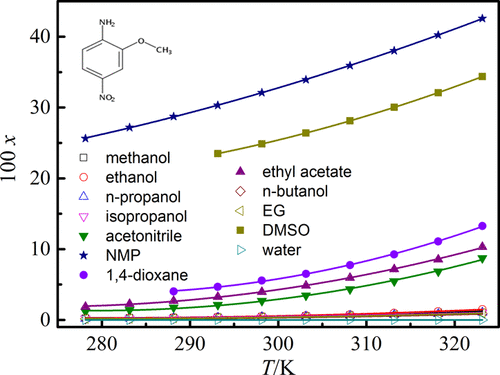当前位置:
X-MOL 学术
›
J. Chem. Eng. Data
›
论文详情
Our official English website, www.x-mol.net, welcomes your
feedback! (Note: you will need to create a separate account there.)
2-Methoxy-4-nitroaniline Solubility in Several Monosolvents: Measurement, Correlation, and Solvent Effect Analysis
Journal of Chemical & Engineering Data ( IF 2.0 ) Pub Date : 2020-01-06 , DOI: 10.1021/acs.jced.9b00991 Yuxin Bao 1 , Jiaxin Wu 1 , Xi Zhao 1 , Hongkun Zhao 1
Journal of Chemical & Engineering Data ( IF 2.0 ) Pub Date : 2020-01-06 , DOI: 10.1021/acs.jced.9b00991 Yuxin Bao 1 , Jiaxin Wu 1 , Xi Zhao 1 , Hongkun Zhao 1
Affiliation

|
The 2-methoxy-4-nitroaniline solubilities in some monosolvents of n-propanol, methanol, ethyl acetate, ethanol, isopropanol, acetonitrile, ethylene glycol (EG), n-butanol, water, dimethyl sulfoxide (DMSO), 1,4-dioxane, and N-methylpyrrolidone (NMP) were reported. Experiments were made via a shake-flask technique within the temperature range of 278.15 to 323.15 K under local atmospheric pressure (101.2 kPa). The change trend of the solubility magnitude in different monosolvents from high to low was as follows: NMP > DMSO > 1,4-dioxane > ethyl acetate > acetonitrile > ethanol > methanol > n-propanol > isopropanol > EG > n-butanol > water. Analysis of X-ray powder diffraction scans indicated that polymorphic transformation or solvate formation did not happen in the selected monosolvents. Mathematical description of the determined solubility was carried out through the common Wilson model, Apelblat equation, NRTL model, and λh equation. The acquired values of maximum relative average deviation and root-mean-square deviation were 5.99% and 23.66 × 10–4, respectively. The correlating results were better with the Apelblat equation than with the other models. The interactions between the solute–solvent molecules and solvent–solvent molecules were examined by the use of the method of linear solvation energy relationships. Moreover, the mixing thermodynamic properties, activity coefficient under infinitesimal concentration, and reduced excess enthalpy were attained by using the Wilson model.
中文翻译:

2-甲氧基-4-硝基苯胺在几种单溶剂中的溶解度:测量,关联和溶剂效应分析
在正丙醇,甲醇,乙酸乙酯,乙醇,异丙醇,乙腈,乙二醇(EG),正丁醇,水,二甲基亚砜(DMSO),1,4-的一些单溶剂中的2-甲氧基-4-硝基苯胺溶解度报道了二恶烷和N-甲基吡咯烷酮(NMP)。通过摇瓶技术在局部大气压(101.2 kPa)下在278.15至323.15 K的温度范围内进行实验。不同单溶剂的溶解度大小从高到低的变化趋势如下:NMP> DMSO> 1,4-二恶烷>乙酸乙酯>乙腈>乙醇>甲醇>正丙醇>异丙醇> EG> n-丁醇>水。X射线粉末衍射扫描分析表明,在选定的单溶剂中未发生多晶型转变或溶剂化物的形成。所确定的溶解度的数学描述是通过共同Wilson模型,Apelblat方程,NRTL模型,和λ进行ħ方程。最大相对平均偏差和均方根偏差的获取值为5.99%和23.66×10 –4, 分别。Apelblat方程的相关结果要好于其他模型。溶质-溶剂分子与溶剂-溶剂分子之间的相互作用通过使用线性溶剂化能量关系的方法进行了研究。此外,通过使用威尔逊模型,获得了混合热力学性质,在最小浓度下的活度系数和降低的过量焓。
更新日期:2020-01-07
中文翻译:

2-甲氧基-4-硝基苯胺在几种单溶剂中的溶解度:测量,关联和溶剂效应分析
在正丙醇,甲醇,乙酸乙酯,乙醇,异丙醇,乙腈,乙二醇(EG),正丁醇,水,二甲基亚砜(DMSO),1,4-的一些单溶剂中的2-甲氧基-4-硝基苯胺溶解度报道了二恶烷和N-甲基吡咯烷酮(NMP)。通过摇瓶技术在局部大气压(101.2 kPa)下在278.15至323.15 K的温度范围内进行实验。不同单溶剂的溶解度大小从高到低的变化趋势如下:NMP> DMSO> 1,4-二恶烷>乙酸乙酯>乙腈>乙醇>甲醇>正丙醇>异丙醇> EG> n-丁醇>水。X射线粉末衍射扫描分析表明,在选定的单溶剂中未发生多晶型转变或溶剂化物的形成。所确定的溶解度的数学描述是通过共同Wilson模型,Apelblat方程,NRTL模型,和λ进行ħ方程。最大相对平均偏差和均方根偏差的获取值为5.99%和23.66×10 –4, 分别。Apelblat方程的相关结果要好于其他模型。溶质-溶剂分子与溶剂-溶剂分子之间的相互作用通过使用线性溶剂化能量关系的方法进行了研究。此外,通过使用威尔逊模型,获得了混合热力学性质,在最小浓度下的活度系数和降低的过量焓。











































 京公网安备 11010802027423号
京公网安备 11010802027423号